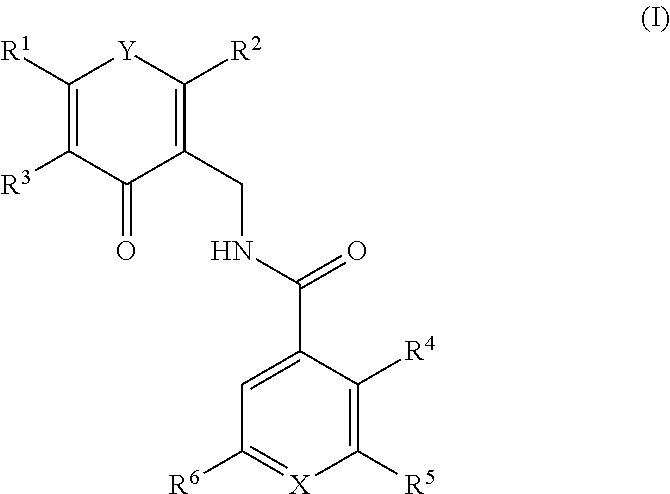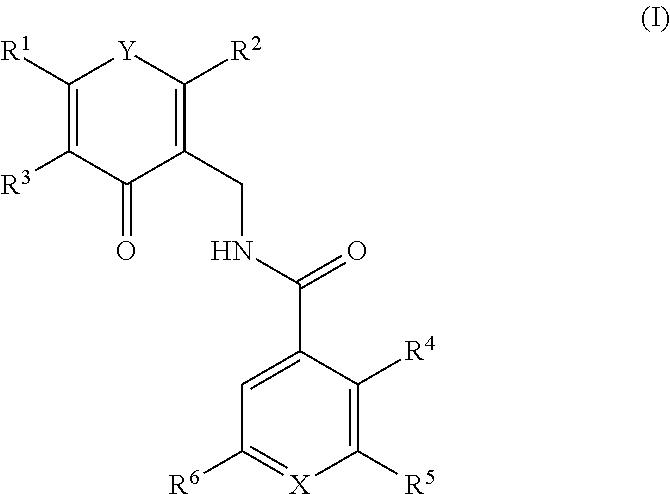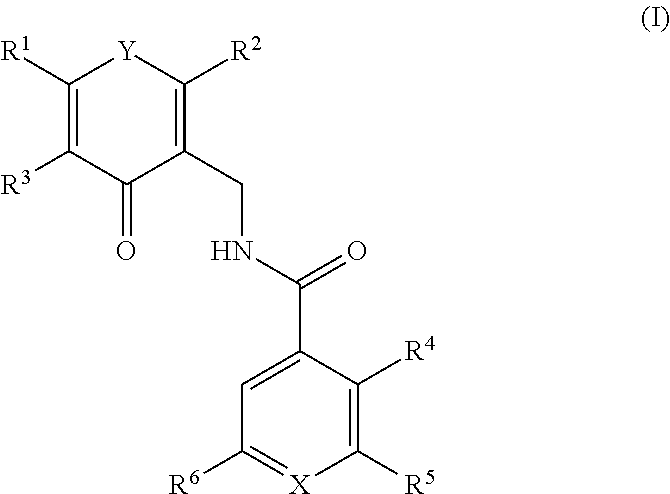Enhancer of zeste homolog 2 inhibitors
a zeste homolog 2 inhibitor and zeste technology, applied in the field of compounds, can solve the problems of increased metastasis, shorter disease-free survival, and increased risk of recurren
- Summary
- Abstract
- Description
- Claims
- Application Information
AI Technical Summary
Benefits of technology
Problems solved by technology
Method used
Image
Examples
example 1
Benzyl 4-(5-chloro-3-(((2,6-dimethyl-4-oxo-1,4-dihydropyridin-3-yl)methyl)carbamoyl)-2-methylphenoxy)piperidine-1-carboxylate
[0262]
a) tert-Butyl 4-(5-chloro-3-(methoxycarbonyl)-2-methylphenoxy)piperidine-1-carboxylate
[0263]
[0264]A mixture of methyl 5-chloro-3-hydroxy-2-methylbenzoate (1.25 g, 6.23 mmol), tert-butyl 4-((methylsulfonyl)oxy)piperidine-1-carboxylate (3.66 g, 13.08 mmol) and cesium carbonate (5.08 g, 15.58 mmol) in DMF (25 mL) was heated at 75° C. for 18 h. The reaction was allowed to cool to ambient temperature and poured into ice / water (200 mL) with stirring. The mixture was extracted with EtOAc (3×100 mL), dried over magnesium sulfate, and concentrated in vacuo. The light yellow residue was purified by flash chromatography (5-50% EtOAc / hexanes) to give tert-butyl 4-(5-chloro-3-(methoxycarbonyl)-2-methylphenoxy)piperidine-1-carboxylate (1.95 g, 5.08 mmol, 82% yield) as a solid. 1H NMR (DMSO-d6) δ 7.37 (d, J=2.0 Hz, 1H), 7.31 (d, J=2.0 Hz, 1H), 4.71 (dt, J=7.4, 3.8 Hz, ...
example 2
5-Chloro-N-((2,6-dimethyl-4-oxo-1,4-dihydropyridin-3-yl)methyl)-2-methyl-3-((tetrahydro-2H-pyran-4-yl)oxy)benzamide
[0272]
a) 5-Chloro-2-methyl-3-((tetrahydro-2H-pyran-4-yl)oxy)benzoic acid
[0273]
[0274]A 100 mL round bottom flask was charged with methyl 5-chloro-3-hydroxy-2-methylbenzoate (500 mg, 2.492 mmol), tetrahydro-2H-pyran-4-ol (318 mg, 3.12 mmol), triphenylphosphine (1307 mg, 4.98 mmol) and tetrahydrofuran (20 mL). The reaction was maintained for 15 min, at which time DIAD (1.454 mL, 7.48 mmol) was added in one portion. The resulting solution was heated at 55° C. for 24 h and then concentrated in vacuo. Purification of the residue by column chromatography (10-50% EtOAc / hexanes) gave methyl 5-chloro-2-methyl-3-((tetrahydro-2H-pyran-4-yl)oxy)benzoate as an orange-oil, which was used directly in the next step. 1H NMR (400 MHz, CHLOROFORM-d) δ 7.42 (d, J=2.02 Hz, 1H), 6.98 (d, J=2.02 Hz, 1H), 4.51 (tt, J=3.73, 7.39 Hz, 1H), 3.99 (ddd, J=3.66, 7.01, 11.31Hz, 2H), 3.91 (s, 3H), 3.64 ...
example 3
5-Chloro-N-((2,6-dimethyl-4-oxo-1,4-dihydropyridin-3-yl)methyl)-2-methyl-3-((1-(pyrimidin-4-yl)piperidin-4-yl)oxy)benzamide
[0278]
a) 1-(Pyrimidin-4-yl)piperidin-4-yl methanesulfonate
[0279]
[0280]A 50 mL round bottom flask was charged with piperidin-4-ol (500 mg, 4.94 mmol), 4-chloropyrimidine (1415 mg, 12.36 mmol), 2-methylbutan-2-ol (16.000 mL, 148 mmol), Hunig's base (3.02 mL, 17.30 mmol) and a magnetic stir bar. The flask was equipped with a reflux condenser and the reaction mixture was heated to 110° C. with stirring overnight, at which time the reaction was allowed to cool to room temperature. The reaction solvent was removed in vacuo and the remaining residue (a thick dark-brown honey) was partitioned between EtOAc and 0.1M HCl / water. The residue was dissolved in MeOH (60 mL) and concentrated (2×). The remaining residue was triturated with diethyl ether but the product did not solidify. The ether was removed in vacuo.
[0281]To a solution of the residue in CHCl3 (40 mL) was added ...
PUM
| Property | Measurement | Unit |
|---|---|---|
| Composition | aaaaa | aaaaa |
| Pharmaceutically acceptable | aaaaa | aaaaa |
Abstract
Description
Claims
Application Information
 Login to View More
Login to View More - R&D
- Intellectual Property
- Life Sciences
- Materials
- Tech Scout
- Unparalleled Data Quality
- Higher Quality Content
- 60% Fewer Hallucinations
Browse by: Latest US Patents, China's latest patents, Technical Efficacy Thesaurus, Application Domain, Technology Topic, Popular Technical Reports.
© 2025 PatSnap. All rights reserved.Legal|Privacy policy|Modern Slavery Act Transparency Statement|Sitemap|About US| Contact US: help@patsnap.com



